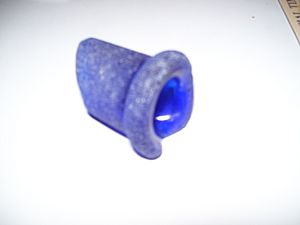Sea glass facts for kids
Sea glass and beach glass are small pieces of glass that have been made smooth by ocean waves. Sea glass is found on beaches along salty waters, like oceans. As glass washes up on the shoreline, strong waves and rocks break it into smaller bits. The sharp edges get worn down and become smooth. Salt water also changes the glass, making it look frosted or cloudy. Beach glass is similar, but it comes from fresh water, like large lakes. Even though they come from different places, many people use the names "sea glass" and "beach glass" to mean the same thing.
What Colors Can Sea Glass Be?
The most common colors of sea glass are white, emerald green, and brown. These often come from old jars, plain bottles, and beer bottles that were thrown into the water.
Some colors are a bit harder to find:
- Olive green
- Cobalt blue
- Aqua (a light blue-green)
- Amber (a yellowish-brown)
These colors often came from old medicine bottles, soda bottles, or cosmetic jars.
The rarest colors of sea glass are red, orange, and yellow. These were once parts of special items like fine china, streetlamps, or even ship lanterns. Sometimes, tiny bubbles inside the glass can help you figure out what the original glass item was. Different colors can also tell you about the time period the glass came from.
How to Find Sea Glass
Many people enjoy walking on beaches to find sea glass. These people are called collectors. It has become harder to find sea glass since plastic containers became popular. This is because fewer glass items are now thrown into the water.
It takes a long time for glass to become smooth and frosted. Sea glass can take about 7 to 10 years to get its frosted look. In many places, winter is often the best time to search for sea glass. Experienced sea glass hunters often look for times of low tide to start their search. Beaches that are cleaned regularly usually do not have much sea glass. Hunters often look for "dirty beaches" that are left alone and have more litter.
Images for kids





